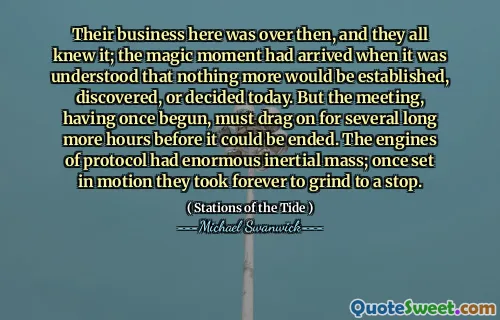
Their business here was over then, and they all knew it; the magic moment had arrived when it was understood that nothing more would be established, discovered, or decided today. But the meeting, having once begun, must drag on for several long more hours before it could be ended. The engines of protocol had enormous inertial mass; once set in motion they took forever to grind to a stop.
This passage vividly captures the often frustrating inertia within bureaucratic or organizational processes. It reflects how, once certain procedures are initiated, they tend to persist far beyond the point of necessary action or resolution. The metaphor of 'engines of protocol' possessing 'enormous inertial mass' underscores a fundamental truth about institutional momentum: change and closure are impeded not solely by external factors but by internal mechanisms that resist rapid cessation. In the context of the story 'Stations of the Tide' by Michael Swanwick, this could symbolize human institutions, corporate meetings, or societal structures where inefficiencies accumulate over time, making real progress arduous. The depiction resonates on a broader level, emphasizing that even when clarity has been reached—when everyone knows the business is concluded—the process of formal ratification or closure remains prolonged. This phenomenon extends into our daily experiences; countless meetings and projects drag on because of procedural inertia, organizational old habits, or rigid protocols. Understanding this dynamic has practical implications: emphasizing streamlined procedures or recognizing when to cut losses can foster efficiency and prevent burnout. Interestingly, this passage also hints at a paradox—how the very structures meant to facilitate decision-making can become obstacles themselves. Recognizing such patterns can lead to more mindful management, promoting agility over sluggishness. The evocative language and vivid metaphor compel us to reflect on the importance of balancing procedural rigor with flexibility, ensuring that institutional inertia does not hinder timely outcomes and that organizational processes serve their intended purpose rather than becoming self-perpetuating obstacles.



